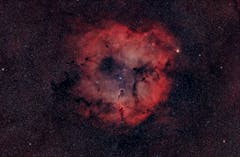Astronomik OIII 6nm CCD MaxFR 36mm
MaxFR Astronomik photographic narrowband-emission line filters for fast optical systems
There is an ever-growing demand for filters suitable for extremely fast optical systems like Celestron's RASA and the Epsilon Astrographs made by Takahashi.
Our novel MaxFR emission line filters are suitable for very fast focal ratios. The new Astronomik MaxFR series of narrowband-emission line filters is perfectly matched to the requirements of astronomical deep-sky imaging with fast optical systems. For the three most important emission lines of oxygen (OIII), hydrogen (H-alpha), and sulfur (SII), you can select filters with either 12nm or 6nm Bandwidth (FWHM).
MaxFR OIII-CCD filter
6nm and 12nm FWHM
MaxFR H-alpha-CCD filter
6nm and 12nm FWHM
MaxFR SIII-CCD filter
6nm and 12nm FWHM
Highest Transmission
Our new MaxFR filters are made in a completely new way, designed to work perfectly with fast optical systems. The well-known MFR Coating technique gives you the best out-of-band blocking possible across the entire range of wavelengths from the UV up to IR! This new design offers extremely high contrast, minimized stray light, no halos, and needle-sharp stars. Astronomik MFR narrowband-emission line filters provide the best data quality, giving you excellent start material for processing into stunning final images!
- For 12nm MaxFR filters, unlimited usability from f/1.7 to f/8, and about 85% of the maximum transmission at f/1.4 as guaranteed.
- For 6nm MaxFR filters, unlimited usability from f/2.2 to f/8, with about 90% of the maximum transmission at f/2 as guaranteed performance data.
For maximum contrast, the SII filter is carefully designed to block all light coming from H-alpha and NII (nitrogen).
Imaging with Narrowband-Emission Line Filters
If you observe from light-polluted sites, imaging with narrowband-emission line filters is the best way to capture great images, as all kinds of light pollution can be effectively blocked. Normally, an H-alpha filter should be your first step into astrophotography. With a Narrowband H-alpha filter, you will take deep and contrasting images even under heavy light pollution or when the full moon is in the sky! OIII filters expand your imaging possibilities, allowing you to image all greenish/blueish structures like planetary nebulae and star-forming regions. The SII filter completes your HSO filter set, enabling you to process your images in ways similar to the Hubble Space Telescope!
Quality aspects of the new Astronomik MFR narrowband-emission line filters:
- MFR Coating: The 12nm filters can be used on all instruments down to f/1.4, the 6nm filters down to f/2.
- High-Quality Substrate: Astronomik filters are made with stress-free, optically polished glass. The filter itself is made of ultra-thin layers on this substrate!
- Parfocal Filters: All Astronomik Filters are Parfocal! Due to the very small thickness-tolerance, the focal plane is not shifted when changing filters.
- Coating: Astronomik filters are made of up to 170 layers, coated on both sides of the substrate. These layers act as an Anti-Reflection Coating.
- Durability: Astronomik filters are highly scratch-resistant, moisture-resistant, and will not degrade over time. Every Astronomik filter delivers full performance and meets specifications even after years of use.
- Integrated Blocking: All unwanted light is blocked across the entire spectral range from UV to IR! You will not need an additional UV/IR-Blocker when imaging with any of our new narrowband-emission line filters.
- Wide range of available sizes – from 1.25" up to square 50mm x 50mm filters.
- Delivered in a high-quality protection & storage box.
- Thanks to our coating technique, we offer a 10-year guarantee on all our filters.
You will get the highest quality possible with every single Astronomik filter, enabling perfect images with your instruments! Especially with filters against light pollution and narrowband-emission line filters, your imaging possibilities will expand enormously. You are investing in an accessory that will continue working for years as it did when new. Due to our special coating technique, the filters do not degrade over time, and the MFR coating ensures compatibility with nearly all instruments!
Common Questions from Customers
- Which is the best full-width-half-maximum for me? 12nm or 6nm?
There is no "right" or "wrong" choice here. If you have a camera with low dark current and effective cooling, the 6nm filters offer advantages: the stronger background blocking allows for longer exposures and deeper images. Stars will appear as tiny points, and many faint stars will not be visible, allowing you to capture faint structures even in star-crowded regions. The 12nm filters are ideal for all DSLRs and dark-current-limited cameras, while the 6nm filters are best for extreme light pollution, low-dark-current cameras, and when weak objects require maximum contrast and star-reduction.
How much is exposure time increased?
While exposure times don't need to be longer, they can be! With high transmission at the center wavelength, nearly all emission line photons reach the sensor, so the number of "H-alpha-photons" doesn't change much whether or not a filter is used. However, blocking unwanted light from UV to IR reduces the background signal, allowing you to expose longer – perhaps 30 minutes instead of 30 seconds – to record fainter structures.
Filter Selection
Select the appropriate size and FWHM to find the right filters for your setup.
















